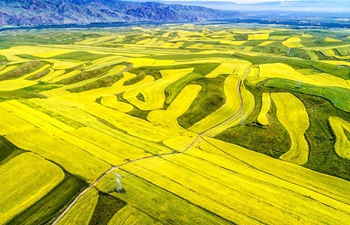By Levi J Parsons
SYDNEY, July 12 (Xinhua) -- A lack of rain in Australia's grain producing region this winter has sparked fears that the country's wheat yields will fall substantially in 2017.
Typically planted in May-June and harvested around November-December, favorable weather conditions during the Aussie winter months from June until the end of August are vital in ensuring the success of a crop.
So far, the dry conditions have many farmers worried.
"Rainfall across most of the Australian wheat belt has been well below average so far this season," GrainGrowers Limited, Trade and Economics Manager Luke Mathews, told Xinhua recently.
"Western Australia, which is our main production and exporting state has seen some of the driest conditions on record over the last three months and that has resulted in a significant decline in planted area and it's also resulted in some very, very poor crop conditions."
"There will be some farmers in Western Australia this year that will be unlikely to pull out the harvester at the end of this season."
The slow start to the season comes off 2016's bumper production year, which produced in excess of over 35 million tonnes of wheat.
This year, private estimates put the figure at least 10 million tonnes below that, around the 23 million ton mark.
National forecaster, Australian Bureau of Agricultural and Resource Economics and Sciences have projected a similar outcome of 24 million tons.
The drastic fluctuations in production levels have seen the price of the commodity spike.
"Over the last few months we have seen a significant rise in the value of Australian grain, but that is somewhat consistent with what we have seen off shore," Mathews explained.
"We have seen some very steep increases in global grain prices over the last couple of months."
"In an Australian context, wheat prices for January 2018 delivery today on the Australian Securities Exchange are trading at around 310 Australian dollars per ton (236.34 U.S. dollars), a few months ago they were back at 240 Aussie dollars per ton (182.98 U.S. dollars) and back in harvest last year around November-December and January prices were trading as low as 210-220 Aussie dollars per ton (160-168 U.S. dollars)."
With some producers in the United States also facing similar challenges in their supply, Mathews said buyers around the world are beginning to grow concerned that the price of wheat could rise even higher.
"Our key export markets are starting to try and secure some supply as we speak," Matthews said.
For Australia, those key export markets predominantly include South East and North Asia.
"Being a large producing nation, with only a relatively small domestic consumption base, we're reliant on export markets, we export roughly two thirds to 70 percent of the wheat that we produce in any one year," Matthews said.
"Indonesia is our primary market from a historical context in the wheat industry, but China is also an incredibly important market."
"Over the last couple of years it's about the 1.2 to 1.4 million ton mark for wheat exports into China."
To make matters worse, Australia's other major winter crops barley and canola are also expected to see significant year on year declines in production.
"It certainly is a worry and it is a significant challenge that farmers across the country are facing at the moment," Mathews said.
"But it's important to note that we are early in the production cycle and even at 23 million tonnes, we are only a couple of million tonnes below what we would deem as a normal Australian wheat crop."
"So sitting here in July, a lot of things could still go right from here on in, but with that said a lot of things could go wrong."
Despite the challenges Aussie farmers face this season, Matthews believes that despite being reliant on in-crop rainfall, Australian farmers over the last decade have made significant improvements in on farm practices.
"Australian farmers today are extremely efficient at utilizing the available moisture and we seem to be able to produce more grain with less rain today than we were five to 15 years ago," Matthews said.
"Some positive developments have occurred, but it is still a challenging environment that we are facing today."

















